Educators don’t have just literature on their shelves. They also have books that help readers understand and appreciate books and their creators; books that serve as guides to the selection and use of literature in classrooms and libraries; and books that remind us of the importance of reading and the joy that books can bring to the lives of readers of all ages.
Comics Confidential: Thirteen Graphic Novelists Talk Story, Craft, and Life Outside the Box. Leonard S. Marcus (Ed.). 2016. Candlewick.
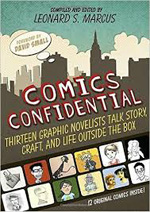 According to Leonard Marcus, writer and historian of children’s literature, the influence of comics is stronger than ever. In an introductory short history of cartoons and comic books, he describes the rise of the graphic novel to its current status as a 21st-century comic. This fascinating documentary includes interviews in a Q&A format with 13 creative and diverse graphic novelists and artists accompanied by a sample of a work in progress and an original graphic short treatment about “the city” created for inclusion in Comics Confidential. My favorite interview is with Gene Luen Yang, who was born in 1973 in California to Chinese immigrants. Geeky as a child and adolescent, he graduated from UC Berkeley with a degree in computer science and a minor in creative writing. Creating satirical stereotypes in his first book, American Born Chinese (2006), Yang addressed issues of racial identity and immigration while he played with new elements of visual story narrative. In his subsequent books and projects, he has continued to develop his art technique, research procedure, and storytelling narrative strategies. He created “Berkeley, California” as a short comic for this book. Comics Confidential is an informative and inspiring book for anyone who wants to learn more about the creative process of this revolutionary mode of visual storytelling.
According to Leonard Marcus, writer and historian of children’s literature, the influence of comics is stronger than ever. In an introductory short history of cartoons and comic books, he describes the rise of the graphic novel to its current status as a 21st-century comic. This fascinating documentary includes interviews in a Q&A format with 13 creative and diverse graphic novelists and artists accompanied by a sample of a work in progress and an original graphic short treatment about “the city” created for inclusion in Comics Confidential. My favorite interview is with Gene Luen Yang, who was born in 1973 in California to Chinese immigrants. Geeky as a child and adolescent, he graduated from UC Berkeley with a degree in computer science and a minor in creative writing. Creating satirical stereotypes in his first book, American Born Chinese (2006), Yang addressed issues of racial identity and immigration while he played with new elements of visual story narrative. In his subsequent books and projects, he has continued to develop his art technique, research procedure, and storytelling narrative strategies. He created “Berkeley, California” as a short comic for this book. Comics Confidential is an informative and inspiring book for anyone who wants to learn more about the creative process of this revolutionary mode of visual storytelling.
—NB
Every Young Child a Reader: Using Marie Clay’s Key Concepts for Classroom Instruction. Sharan A. Gibson & Barbara Moss. 2016. Teachers College.
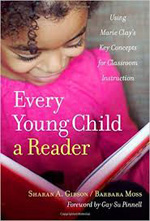 Beginning in the early 1970s and continuing after her death in 2007, New Zealand’s Marie Clay, a developmental psychologist and literacy development expert, has transformed how young readers are taught through applications of her transformative literacy processing theory via Reading Recovery and other programs. Gibson and Moss revisit Clay’s four essential principles: literacy processing is complex, there is a reciprocal relationship between reading and writing, continuous text exposure is essential to reading development, and experiencing diverse text complexity is necessary for the development of higher level literacy skills. The authors present differentiated teaching applications for individual learners within whole-class, small-group, and occasional one-on-one instruction, along with examples such as a detailed description of an interactive read-aloud with teacher questioning. They discuss the importance of integrated cross-disciplinary literacy instruction, exposure to informational texts, participation in thematic units, and the conducting of research projects in the building of knowledge by students. An epilogue challenges teachers, as educational leaders, to take action based on Clay’s principles to build comprehensive literacy programs to develop children who are strong readers and writers.
Beginning in the early 1970s and continuing after her death in 2007, New Zealand’s Marie Clay, a developmental psychologist and literacy development expert, has transformed how young readers are taught through applications of her transformative literacy processing theory via Reading Recovery and other programs. Gibson and Moss revisit Clay’s four essential principles: literacy processing is complex, there is a reciprocal relationship between reading and writing, continuous text exposure is essential to reading development, and experiencing diverse text complexity is necessary for the development of higher level literacy skills. The authors present differentiated teaching applications for individual learners within whole-class, small-group, and occasional one-on-one instruction, along with examples such as a detailed description of an interactive read-aloud with teacher questioning. They discuss the importance of integrated cross-disciplinary literacy instruction, exposure to informational texts, participation in thematic units, and the conducting of research projects in the building of knowledge by students. An epilogue challenges teachers, as educational leaders, to take action based on Clay’s principles to build comprehensive literacy programs to develop children who are strong readers and writers.
—NB
Excellent Books for Early and Eager Readers. Kathleen T. Isaacs. 2016. American Library Association.
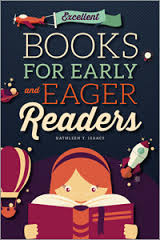 Young, eager readers read at an early age, employ multiple reading strategies, may develop unique reading interests, read three to four times more than most children, and are most likely to become voracious lifelong readers. Isaacs considers ways in which teachers, librarians, and families can help these children overcome two major challenges: to find enjoyable and interesting reading materials that meet their special reading interests and to select books that are developmentally appropriate. Isaacs offers an informative look at her research, describes how she chose the books she recommends, and explores the topic of “What Makes a Good Children’s Book and What Makes a Good Book for a Young Reader?” Through conversations and interviews with parents, booksellers, teachers, and librarians, Isaacs gathered information about early and eager readers—their similarities and differences and their reading preferences. Her findings resulted in this book, in which she recommends a mix of 300 old and new titles for eager readers from ages 4 to 10. Each chapter focuses on a specific topic such as “Talking Animals and Tiny People” and “Witches and Wizards and Magic,” and entries contain information about interest levels and Lexile levels (independent reading levels which encourage reading development) and annotations with interesting insights. Isaacs’s book is an excellent resource for those seeking books that encourage, challenge, and support already excellent young readers.
Young, eager readers read at an early age, employ multiple reading strategies, may develop unique reading interests, read three to four times more than most children, and are most likely to become voracious lifelong readers. Isaacs considers ways in which teachers, librarians, and families can help these children overcome two major challenges: to find enjoyable and interesting reading materials that meet their special reading interests and to select books that are developmentally appropriate. Isaacs offers an informative look at her research, describes how she chose the books she recommends, and explores the topic of “What Makes a Good Children’s Book and What Makes a Good Book for a Young Reader?” Through conversations and interviews with parents, booksellers, teachers, and librarians, Isaacs gathered information about early and eager readers—their similarities and differences and their reading preferences. Her findings resulted in this book, in which she recommends a mix of 300 old and new titles for eager readers from ages 4 to 10. Each chapter focuses on a specific topic such as “Talking Animals and Tiny People” and “Witches and Wizards and Magic,” and entries contain information about interest levels and Lexile levels (independent reading levels which encourage reading development) and annotations with interesting insights. Isaacs’s book is an excellent resource for those seeking books that encourage, challenge, and support already excellent young readers.
—NB
Lit Up: One Reporter. Three Schools. Twenty-Four Books That Can Change Lives. David Denby. 2016. Henry Holt.
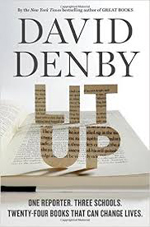 “How do you establish reading pleasure in busy, screen-loving teenagers—and in particular, pleasure in reading serious work?” Reporter David Denby set out to answer this when he spent the 2011–2012 school year observing an ethnically and economically diverse 10th-grade English class in Beacon School, a magnet public high school in New York City’s Manhattan borough. On the first day of school, teacher Sean Leon discussed what the class would be reading under the year’s “individual and society” theme—“You are going to read books that make you uncomfortable”—and what would be expected of them. Denby read all the literature that the students read throughout the year including Kurt Vonnegut’s Slaughterhouse-Five,Fyodor Dostoevsky’s Notes From Underground, Jean-Paul Sartre’s No Exit, and other challenging books. He comments on the books, Leon’s guidance of discussions, and the students’ involvement in the books read throughout the year. During the following school year, Denby visited both an inner-city 10th-grade English class in New Haven, CT, in which students had a common reading list as well as some choice between pairs of books, and a school in an affluent Westchester County, NY, community in which students made independent reading choices in addition to doing the core reading. From his experiences, Denby concluded that, under the guidance of passionate, committed teachers who are free to develop their own curricula, teenagers can become serious readers who take pleasure in reading.
“How do you establish reading pleasure in busy, screen-loving teenagers—and in particular, pleasure in reading serious work?” Reporter David Denby set out to answer this when he spent the 2011–2012 school year observing an ethnically and economically diverse 10th-grade English class in Beacon School, a magnet public high school in New York City’s Manhattan borough. On the first day of school, teacher Sean Leon discussed what the class would be reading under the year’s “individual and society” theme—“You are going to read books that make you uncomfortable”—and what would be expected of them. Denby read all the literature that the students read throughout the year including Kurt Vonnegut’s Slaughterhouse-Five,Fyodor Dostoevsky’s Notes From Underground, Jean-Paul Sartre’s No Exit, and other challenging books. He comments on the books, Leon’s guidance of discussions, and the students’ involvement in the books read throughout the year. During the following school year, Denby visited both an inner-city 10th-grade English class in New Haven, CT, in which students had a common reading list as well as some choice between pairs of books, and a school in an affluent Westchester County, NY, community in which students made independent reading choices in addition to doing the core reading. From his experiences, Denby concluded that, under the guidance of passionate, committed teachers who are free to develop their own curricula, teenagers can become serious readers who take pleasure in reading.
—CA
Picture This: How Pictures Work (Revised and Expanded 25th Anniversary Edition). Molly Bang. 2016. Chronicle.
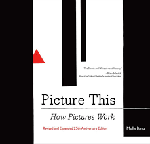 This guidebook explores an intriguing question: How does the structure of a picture—or any visual art form—affect our emotional response? To illustrate her points, Bang begins with examples related to artwork for “Little Red Riding Hood.” Using a think-aloud strategy, she analyzes how geometric shapes, colors, placement, and so on engage a reader’s emotional interpretations and connections to the narrative. Bang presents 12 principles (e.g., “smooth, flat, horizontal shapes give us a sense of stability and calm”) through simple art and explanations. Using her picture book When Sophie Gets Angry—Really, Really Angry (2004), Bang describes how she created artwork to portray Sophie’s feelings of fury, sadness, expectancy, contentment, and contemplation. Through an illustration from her book, Dawn (1983), an adaptation of “The Crane Wife,” a Japanese folk tale, she encourages readers to analyze how this artwork affects their feelings, and then invites them to create, revise, and analyze their own scary picture using colored cut-paper art. Bang includes a list of further art exercises so readers can apply what they have learned. In this revision, she has fine-tuned her layouts and accompanying descriptions and analyses of examples for readers of all ages who want to produce art and/or understand it and how it affects the human spirit.
This guidebook explores an intriguing question: How does the structure of a picture—or any visual art form—affect our emotional response? To illustrate her points, Bang begins with examples related to artwork for “Little Red Riding Hood.” Using a think-aloud strategy, she analyzes how geometric shapes, colors, placement, and so on engage a reader’s emotional interpretations and connections to the narrative. Bang presents 12 principles (e.g., “smooth, flat, horizontal shapes give us a sense of stability and calm”) through simple art and explanations. Using her picture book When Sophie Gets Angry—Really, Really Angry (2004), Bang describes how she created artwork to portray Sophie’s feelings of fury, sadness, expectancy, contentment, and contemplation. Through an illustration from her book, Dawn (1983), an adaptation of “The Crane Wife,” a Japanese folk tale, she encourages readers to analyze how this artwork affects their feelings, and then invites them to create, revise, and analyze their own scary picture using colored cut-paper art. Bang includes a list of further art exercises so readers can apply what they have learned. In this revision, she has fine-tuned her layouts and accompanying descriptions and analyses of examples for readers of all ages who want to produce art and/or understand it and how it affects the human spirit.
—NB
The View From the Cheap Seats: Selected Nonfiction. Neil Gaiman. 2016. William Morrow/HarperCollins.
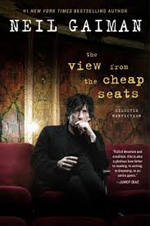 Neil Gaiman describes this book as “a motley bunch of speeches and articles, introductions and essays,” and it does include his nonfiction writing on a wide range of topics, issues, and people who matter to him. It also gives readers a look at Gaiman’s life story, including his love of reading at a young age and the authors he credits with making him the writer he is today:
Neil Gaiman describes this book as “a motley bunch of speeches and articles, introductions and essays,” and it does include his nonfiction writing on a wide range of topics, issues, and people who matter to him. It also gives readers a look at Gaiman’s life story, including his love of reading at a young age and the authors he credits with making him the writer he is today:
C.S. Lewis, J.R.R. Tolkien, and G.K. Chesterton, and his appreciation for all the arts and the people who make them. Throughout the book, Gaiman communicates his belief in the importance of reading: “I hope we can give our children a world in which they will read, and be read to, and imagine, and understand.” He speaks to readers in a conversational tone that is witty, wise, and thought provoking. Each entry is worth reading again and again and leaves readers with books to add to their I-want-to-read-or-read-again booklists.
—CA
Young Adult Literature: From Romance to Realism (3rd Edition). Michael Cart. 2016. American Library Association.
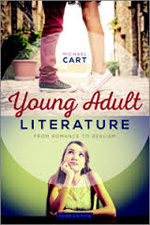 This revised, updated, and expanded third edition of Michael Cart’s survey of young adult literature, which began with the publication of From Romance to Realism: 50 Years of Growth and Change in Young Adult Literature in 1996, is essential reading for anyone who wants to be current on the field. Maintaining the “That Was Then” and “This Is Now” format of earlier editions, Cart presents the history of young adult novels by decades, beginning with the 1960s and then shifting to a consideration of changes and trends in young adult literature in the 21st century, ushered in with the announcement of the first-ever winner of the Michael L. Printz Award at the American Library Association Midwinter conference on January 12, 2000. Cart states that the winning book, Walter Dean Myers’s Monster, and the four honor books “exemplified the newly literary, innovative, and diverse nature of young adult literature,” heralding the revival and renaissance of young adult literature. He covers a range of topics including genre fiction, teen demographics (Cart doesn’t shy away from presenting statistics), and the marketing of YA books (including the expanded audience for young adult books). He offers a balanced consideration of issues and their treatment by contemporary authors in addition to hot topics such as “the new nonfiction,” the boom in audiobooks, and the rise of new literacies in the age of change in technology. Cart leaves readers with thought-provoking comments on the promising future of young adult literature.
This revised, updated, and expanded third edition of Michael Cart’s survey of young adult literature, which began with the publication of From Romance to Realism: 50 Years of Growth and Change in Young Adult Literature in 1996, is essential reading for anyone who wants to be current on the field. Maintaining the “That Was Then” and “This Is Now” format of earlier editions, Cart presents the history of young adult novels by decades, beginning with the 1960s and then shifting to a consideration of changes and trends in young adult literature in the 21st century, ushered in with the announcement of the first-ever winner of the Michael L. Printz Award at the American Library Association Midwinter conference on January 12, 2000. Cart states that the winning book, Walter Dean Myers’s Monster, and the four honor books “exemplified the newly literary, innovative, and diverse nature of young adult literature,” heralding the revival and renaissance of young adult literature. He covers a range of topics including genre fiction, teen demographics (Cart doesn’t shy away from presenting statistics), and the marketing of YA books (including the expanded audience for young adult books). He offers a balanced consideration of issues and their treatment by contemporary authors in addition to hot topics such as “the new nonfiction,” the boom in audiobooks, and the rise of new literacies in the age of change in technology. Cart leaves readers with thought-provoking comments on the promising future of young adult literature.
—CA
Nancy Brashear is Professor Emeritus of English from Azusa Pacific University, in Azusa, CA. Carolyn Angus is former director of the George G. Stone Center for Children's Books, Claremont Graduate University, in Claremont, CA.
These reviews are submitted by members of the International Literacy Association's Children's Literature and Reading Special Interest Group (CL/R SIG) and are published weekly on Literacy Daily.